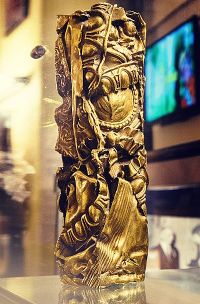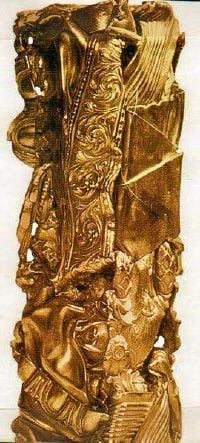| César Awards | |
 César Award | |
| Awarded for | Achievements in French cinema |
|---|---|
| Country | France |
| Presented by | Académie des Arts et Techniques du Cinéma |
| Website | Académie des César |
The César Award is the national film award of France. The awards are presented in the Nuit des César, a nationally televised award ceremony held in Paris each year in February. It is an initiative of the Académie des Arts et Techniques du Cinéma (Academy of Cinema, Art and Techniques), which was founded in 1975, with the first awards given in 1976.
The name of the award comes from the sculptor César Baldaccini (1921–1998) who designed the trophy.
The César Award is considered the highest film honor in France, the French film industry's equivalent to the Molière Award for theatre, and the Victoires de la Musique for music. In cinema, it is the French equivalent to the Academy Award.
History
In 1974, Georges Cravenne, who was also the creator of the Molière Award for achievement in live French theatre, founded the Academy of Arts and Techniques of Cinema that was, from the outset, intended to reward the achievements and the most remarkable film artwork, to have a French equivalent to the American Oscars:
It brings together professionals from the film industry and personalities who have chosen to come together in order to recall the eminently collective nature of film creation, and to draw the public’s attention to these professionals who, through the passionate and demanding combination of their skills, underpin the essential singularity of cinema film.[1]
The first César Awards – also known as the "Night of Caesar" – were held on April 3, 1976 at the Théâtre de l'Empire in Paris, under the chairmanship of Jean Gabin, who watched the ceremony from the front row seated in a wheelchair a few months before his death.
The César Awards replaced the Étoile de cristal, which was awarded from 1955 to 1975. Other prizes had been awarded to French cinema in the past. From 1934 to 1986, the Grand prix du cinéma français, established by film pioneer Louis Lumière, was given to one film a year. In the 1950s, the Victoire du cinéma français was awarded each June. Lacking popular enthusiasm compared to the Étoile de cristal, this award was discontinued after 1964.
At the inaugural César Awards, 13 awards were distributed. Today, there are 22 (in nine subcategories). Categories added in recent years include Most Promising Actor/Actress (Meilleur espoir), Best Documentary (Meilleur documentaire) and Best Animated Film (Meilleur film d'animation), while awards honoring the best film poster and best producer have been dropped, as they are now given at a sister ceremony, the Prix Daniel Toscan du Plantier.
Beginning with the 43rd César ceremony in 2018, a new special award, the César du public, has been given to the French film with the most box office receipts during the previous year and the beginning of the current year.[2] This award is a response to the need to reward French comedy films, which remain the most popular genre in France.[3][4]
The award ceremony is televised every year. The location of the ceremony in Paris has changed over the years. It was held in the Théâtre du Châtelet from 2002 to 2016. In 2017, the Salle Pleyel hosted the ceremony for the first time in 36 years, and it continued to be held there through 2020. From 2021 the award ceremony has been held in the Olympia Hall.
In recent years, especially after the infamous 2020 César awards ceremony in Paris, which saw protests and walkouts, the organization has been making efforts to revamp its image while retaining its traditions. This began with the ousting of France’s Academy of Cinema Arts and Techniques longtime president Alain Terzian, the resignation of the entire board, and a complete overhaul of membership. Changes include increasing the number of César voters who are women, barring anyone convicted of or under investigation for sexual misconduct from participation in the events, as well as allowing the public to view traditionally private events through video posts, [5]
The statue
The César statues are compressed sculptures of metal objects, designed in 1975 by the sculptor César Baldaccini, a friend of Georges Cravenne. Cravenne wanted to create a French equivalent to the Oscars:
The idea of creating a French equivalent germinated in me, until the day when the name of my friend César, a sculptor of genius, imposed itself on me and his sculpture with him. Oscar, César, five letters that rhymed to such an extent that the birth of the second one had become obvious, for the greater good of the promotion of cinema, in Europe in any case.[1]
The name of the award comes from the sculptor César, designer of the trophy awarded to the winners in each category. The name "César" not only is that of the sculptor, it is also an homage to Raimu, the great French actor and performer of the Marseille trilogy by Marcel Pagnol; Raimu played the character of César.[6]
Baldaccini's first design, a man unwrapping a reel of film, was based on the Oscar sculpture,[7] and was highly criticized.
The redesigned trophy is forged from polished natural bronze, unlike the Oscars which are plated in gold. César created a first version for the 1976 Ceremony. In 1977, before a mixed reception of actors, Baldaccini unveiled the current 30cm compression, weighing 3.7 kg and cast in the Bocquel foundry in Normandy.[1]
Voting process
Voting for César Awards is conducted through two ballots by mail: the first to establish nominations per category (three to five, depending on the discipline), and the second to decide the winner. The Académie is responsible for organizing the viewing of eligible films, and sending members the voting materials for the first and second rounds. It also manages the procedures for voting and counting the results.[8]
The nominations are selected by the members of twelve categories of filmmaking professionals. Voters are professionals in the field, numbering about 4,000, divided into the twelve categories (actors, directors, writers, technicians, producers, distributors and international vendors, operators, agents artistic, technical industries, casting directors, press officers, and members associates).
To aid voters, the Académie identifies each year films released in France and provides a guide to the works and eligible professionals. Until recently, a DVD set of French or primarily French productions produced during the year is sent in December with the catalog of films to the electors. Today a viewing platform to maximizes exposure for all of the eligible titles.[5] The update is key for ensuring voters have seen all or most of the films. After the nominations are revealed, at the end of January, special screenings of the nominated films are shown at the Le Balzac cinema in Paris, near the Champs-Élysées.
Categories
Merit awards
|
|
Special awards
- Honorary Award - since 1976
- César des Césars - between 1985 and 1995
- Prix Daniel Toscan du Plantier - since 2008
- Trophée César & Techniques - since 2011
- Médaille d'Or - only in 2015
- César & Techniques Special Award - only between 2015 and 2017
- César & Techniques Innovation Award - since 2018
- César du public - since 2018
Retired awards
- Best Film from the European Union (2002–2004)
- Best Poster (1986–1990)
- Best Producer (1995–1996)
- Best Writing (Adaptation or Original) (1976–2005)
- Best French Language Film (1984–1986)
- Best Documentary Short (1977–1991)
- Best Fiction Short (1977–1991)
- Best Animated Short (1977–1990)
Controversies
In 1993, a controversy arose over the language of films eligible for the awards. The Academy of Cinema, Art and Techniques decided that only francophone movies would be eligible for nomination, making even French productions with English as the spoken language were ineligible. They claimed that the move was to preserve French cultural identity and to protect French cinema from American competition. The decision was so controversial that the academy changed the rule, applying only to the Best Film category. Later even that restriction was removed.[9]
In 2020, Roman Polanski was given the award for Best Director for the movie J'Accuse (An Officer and a Spy) about the Dreyfus Affair. During the ceremony, Adèle Haenel, a French actress playing the main character in Portrait of a Lady on Fire, left the room when Roman Polanski's award for best director was announced. She was protesting the fact that notable sexual abusers in the film industry can receive awards when their victims are reduced to silence.[10] Polanski was convicted of unlawful sexual intercourse with a 13-year-old in California in 1978, and has additionally been accused of other incidents of rape.[11] Haenel was not the only one to walk out in protest; she was joined by the rest of the women behind the internationally acclaimed but mostly snubbed film Portrait of a Lady on Fire.[12] Filmmaker Céline Sciamma was heard to exclaim as she left, “Bravo la pédophilie!”[13]
Notes
- ↑ 1.0 1.1 1.2 Birth of the Academy Académie des César. Retrieved August 21, 2023.
- ↑ Edito: quand nos César font Boon Ecran Noir (February 1, 2018). Retrieved August 21, 2023.
- ↑ Réjane Hamus-Vallée and Caroline Renouard, Les effets spéciaux au cinéma: 120 ans de créations en France et dans le monde (Paris, France: Armand Colin, 2018, ISBN 2200619820).
- ↑ Les César annoncent la création d’un prix du public Le Parisien (January 31, 2018). Retrieved August 21, 2023.
- ↑ 5.0 5.1 Rebecca Leffler, César awards head on revamping its image and growing new audiences Screen Daily (February 8, 2023). Retrieved August 23, 2023.
- ↑ Yannick Dehée and Agnès Chauveau, Dictionnaire de la télévision française (Nouveau Monde Editions, 2007, ISBN 978-2847362657).
- ↑ Le sculpteur César posant avec la première version du trophée, uniquement remis en 1976 Retrieved August 21, 2023.
- ↑ The Academy Académie des César. Retrieved August 22, 2023.
- ↑ Camille Bello, Five things you might not know about the César awards Euro News (March 2, 2018). Retrieved August 16, 2023.
- ↑ Vincent Gibert, César 2020: Claire Denis n'a pas hésité avant de remettre le prix à Roman Polanski Huff Post (March 1, 2020). Retrieved August 23, 2023.
- ↑ Elian Peltier, Adèle Haenel: France 'Missed the Boat' on #MeToo The New York Times (February 24, 2020). Retrieved August 23, 2023.
- ↑ Sarah Williams, What Happened at the César Awards Was a Setup For SilenceAwards Watch (February 29, 2020). Retrieved August 23, 2023.
- ↑ Yohana Desta, Can the César Awards Ever Recover From Roman Polanski Catastrophe? Vanity Fair (March 2, 2020). Retrieved August 23, 2023.
ReferencesISBN links support NWE through referral fees
- Dehée, Yannick, and Agnès Chauveau. Dictionnaire de la télévision française. Nouveau Monde Editions, 2007. ISBN 978-2847362657
- Gillain, Anne, and Dudley Andrew. Truffaut on Cinema. Indiana University Press, 2017. ISBN 978-0253026392
- Hamus-Vallée, Réjane, and Caroline Renouard. Les effets spéciaux au cinéma: 120 ans de créations en France et dans le monde. Paris, France: Armand Colin, 2018. ISBN 2200619820
- Lanzoni,Rémi Fournier. French Cinema: From Its Beginnings to the Present. Bloomsbury Academic, 2015. ISBN 978-1501303074
External links
All links retrieved December 3, 2023.
- Académie des César Official website
- César Awards, France IMDb
Credits
New World Encyclopedia writers and editors rewrote and completed the Wikipedia article in accordance with New World Encyclopedia standards. This article abides by terms of the Creative Commons CC-by-sa 3.0 License (CC-by-sa), which may be used and disseminated with proper attribution. Credit is due under the terms of this license that can reference both the New World Encyclopedia contributors and the selfless volunteer contributors of the Wikimedia Foundation. To cite this article click here for a list of acceptable citing formats.The history of earlier contributions by wikipedians is accessible to researchers here:
The history of this article since it was imported to New World Encyclopedia:
Note: Some restrictions may apply to use of individual images which are separately licensed.

